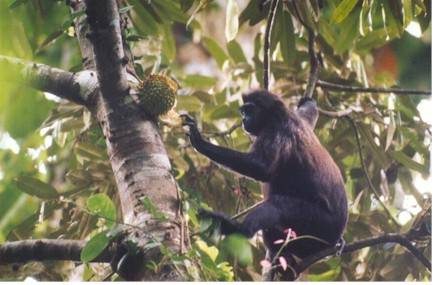TTMT 077 Pig-tailed Langur Traditional Cache
TTMT 077 Pig-tailed Langur
-
Difficulty:
-

-
Terrain:
-

Size:  (micro)
(micro)
Please note Use of geocaching.com services is subject to the terms and conditions
in our disclaimer.
CONTAINER TYPE: Centrifuge Tube
Welcome to the Team Trunk Monkey Turnpike - "TTMT"
This series of caches runs along this stretch of 4-lane road, which features a wide paved shoulder along it's entire course. These caches will all be on the South / East side of the road. There will be caches of several different sizes and types, and the hiding spots will vary in difficulty and terrain, as the locations allow. As such, several of these caches will have you walking through tall grass & looking through vegetation. During the "tick season" it is highly recommended to use a quality insect repellent, and as always if it is sunny out, use a good sunblock too.
**************************************************

Pig-tailed Langur
Nasalis concolor
MORPHOLOGY:
The nasal bones of the pig-tailed langur are elongated and the nose is snubbed. The average body mass for an adult male pig-tailed langur is around 8.7 kilograms, and it is around 7.1 kilograms for females. The hindlimbs and forelimbs of this species are equal in length. This species is sexually dimorphic in terms of body size and canine size. This species is asexually dichromatic, meaning any sex can be of one of two color types. The two color types are a dark gray color and a light buff color. The face of this species is black in color. This species has a relatively short tail for colobines and the tail is hairless. This species shows a preference for what hand it uses during feeding and support.
RANGE:
The pig-tailed langur is found on the Mentawai Islands which are off of the west coast of Sumatra. The four main islands consist of Siberut, Sipora, North Pagai, and South Pagai. This species lives in primary forests on hillsides of the interior region of the islands. The pig-tailed langur also lives in fresh-water and brackish-water swamp forest and lowland rainforest.
ECOLOGY:
The pig-tailed langur is primarily a folivorous species, but also consumes fruits and berries. On the island of Simalegu this species consumes most frequently the species nibung, an inflorescence plant. When this species enters a food tree, it will forage in the more densely foliated part of the tree and feed quietly. The pig-tailed langur has feeding peaks in the morning and in the late afternoon. When feeding groups will break up and spread out over an area of up to 90 meters in diameter. Females with infants will park their infants in a tree crown while they feed. Infants will sometimes cry when placed in the crown of a tree while their mother forages. The advantages of infant parking are that a female might not have use as much energy when foraging if she would have to carry an infant, and a female might be better able to flee from predators if not having to carry an infant around. The pig-tailed langur has a preference to feed with the right hand when the non-feeding hand is not engaged in any activity.
Group sizes for this species, on the islands of Simalegu and Sinaka, range from 1 to 5 individuals. The pig-tailed langur is a diurnal and semi-terrestrial species. This species sleeps in the densely foliated emergent trees found on hillsides. This species was also found to sleep in densely foliated trees in the secondary layer of the canopy. Group travel is lead by either sex.
To avoid predators, mostly humans, this species will remain motionless in dense foliage, not making a sound. The pig-tailed langur will also drop to the ground and try to flee.
Additional Hints
(Decrypt)
Cnlcubar